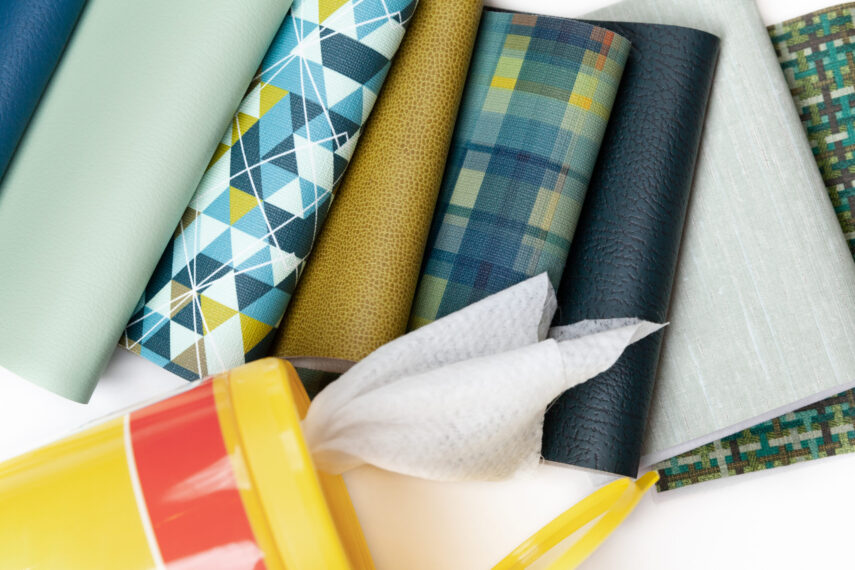
The ability to clean and disinfect is the specification driver amidst the pandemic and will be for the foreseeable future. Now, designers across all fields (and not just healthcare) are faced with the challenge of specifying textiles that will withstand harsh disinfectant cleaners prone to damage and degrade textiles.
Questions to ask for proper textile specification in regards to cleaning and disinfection:
What types of cleaners and disinfectants are used throughout the facility? What are their active ingredients? And are there any areas where multiple types of cleaners are used on the same surface?
It is essential for both designers and environmental services to know the active ingredient(s) of the cleaning products used within the facility. The majority of disinfectant cleaners can now be categorized into seven active ingredients or processes as their base for efficacy. To identify the active ingredient of a cleaner, look at Section 3 of its SDS sheet ((example) (no SDS for UV-C Light)). These ingredients provide efficacy (proof of kill) for the various chemical products used.
The seven common active ingredients in Disinfectant Cleaners:
- Acid-Based
- Alcohol-Based
- Bleach (aka sodium hypochlorite)-Based
- Peroxide-Based
- Phenolic-Based
- Quaternary Ammonium (aka Quat)-Based
- UV-C Light-Based
Knowing the active ingredient will help ensure proper textile specification and maintenance.
What is the frequency of cleaning, and by what method?
Methods may include:
- Wipes
- Sprays
- Foggers
- UV-C lights
Is cleaning, sanitizing, or disinfecting required?
Cleaning refers to the removal of germs, dirt, and impurities from surfaces. It does not kill germs, but by removing them, it lowers their numbers and the risk of spreading infection.
Sanitizing refers to the reduction of the number of microorganisms and bacterial contaminants of public health important to safe levels as judged by public health requirements without adversely affecting the quality of the product or its safety. Porous surfaces (such as woven textiles) may only be sanitized even when disinfectant cleaners are utilized.
Disinfecting refers to using chemicals, for example, EPA-registered disinfectants, to kill germs on surfaces. This process does not necessarily clean dirty surfaces or remove germs, but by killing germs on a surface after cleaning, it can further lower the risk of spreading infection. Non-porous surfaces (such as non-woven textiles) may be disinfected.
Cleaning is required prior to sanitizing or disinfecting any surface, including textiles.
Step 1: Clean
Step 2: Sanitize (porous surfaces – woven textiles)
OR
Step 2: Disinfect (non-porous surfaces – non-woven textiles)
In general, woven upholstery textiles are porous and therefore, can only be sanitized. You cannot get to the level of disinfection due to the nature of soft surfaces even when using disinfectants for upholstery. Use sanitizing cleaners approved for porous, soft surfaces only to prevent damage and/or disintegration of the textile. Textiles that are non-porous, such as non-wovens (ex: polyurethane, silicone, vinyl), are disinfectable. For privacy curtains, launder to CDC recommendation of 160° F.
Disinfecting for Covid-19
The EPA has declared their Emerging Pathogen Policy active for Covid-19. This policy happens when a new strain of a virus or bacteria presents itself as SARS did a few years ago. Under this policy, only EPA registered disinfectants that contain both the Human Coronavirus and SARS claim should be used to kill Covid-19.
How can I make sure the fabrics I select will endure these aggressive cleaning protocols without damage or degradation?
Before specification, ensure the fabrics selected have indeed gone through rigorous durability to cleaner testing. Remember, not all cleaning tests are created equal; some tests pass fabrics after one application, others up to 4000 applications. Once a test report is received, review the test method to determine how rigorous of a test it is, what constitutes a ‘passing grade,’ as well as if the test is based on superficial surface evidence (color bleaching) or if it has been further tested to ensure that the cleaner did not degrade its hydrolytic stability (non-wovens) or tensile strength (wovens).
Architex Fabrics engages a 3rd party testing lab to administer its durability to cleaner testing. Textiles that receive a passing grade undergo 4,000 cleaning cycles, which is the equivalent to 11 cleanings per day for a year!
You’re Ready!
With the above knowledge and answers, all designers can now appropriately make textile selections best suited for the environment and cleaning requirements.
About the Author:
Lauren Williams is the Vice President of Product and Marketing at Architex Fabrics. She resides in Chicago with her husband and loves warm summer days and a crisp Gruner Veltliner.